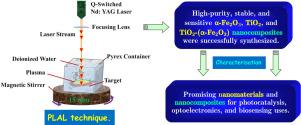当前位置:
X-MOL 学术
›
Mater. Chem. Phys.
›
论文详情
Our official English website, www.x-mol.net, welcomes your feedback! (Note: you will need to create a separate account there.)
Elucidating the structural and spectroscopic attributes of titania-iron oxide (TiO2-([formula omitted]-Fe2O3)) nanocomposites: Showcasing a pulsed laser ablation in liquid approach
Materials Chemistry and Physics ( IF 4.6 ) Pub Date : 2024-03-26 , DOI: 10.1016/j.matchemphys.2024.129235 Teflah K. Alshammari , S.K. Ghoshal , H. Bakhtiar , A.A. Salim , S.S. Alias
Materials Chemistry and Physics ( IF 4.6 ) Pub Date : 2024-03-26 , DOI: 10.1016/j.matchemphys.2024.129235 Teflah K. Alshammari , S.K. Ghoshal , H. Bakhtiar , A.A. Salim , S.S. Alias

|
Various nanomaterials with tailored photo-electrochemical and physicochemical attributes became viable for the photo-catalysis and sensors applications. Thus, some new types of TiO-(-FeO) nanocomposites were made via the pulse laser ablation in liquid method. These nanocomposites at each value of laser fluence were obtained by mixing the colloidal TiO nanoparticles and colloidal (-FeO) nanoparticles at equal ratio. The stability, structures, morphologies, and optical characteristics of the produced nanocomposites (suspended in deionized water) were customized by changing the laser fluence from 3.5–17.7 J cm. The high-resolution transmission electron microscopy micrographs showed the existence of homogeneous dispersion of spherical nanocrystallites (mean diameter 12.4 ± 6.0 nm) in the colloidal suspension. Both X-ray diffraction and Fourier transform infrared profiles of the specimen verified their purity and good nanocrystallinity. Two optical absorption peaks were probed in the range of 240 to 380 nm convoyed by a blue-shift. The spectral edge related to UV–Vis absorption was used to estimate the optical band gap of these nanocomposites. TiO-(-FeO) nanocomposites made at optimum laser fluence (10.6 J cm) exhibited strong fluorescence with the life time decay of 3.64 s, indicating the electronic density of states modification due to quantum size effects. The presence of Fe, Ti, and O in the X-ray photoelectron spectroscopy spectra reaffirmed the samples purity. The measured strong negative zeta potential (-33.1 mV) of the optimum TiO-(-FeO) nanocomposites confirmed their excellent stability in the colloidal suspension. In short, these nanocomposites may be advantageous as good photo-catalysts for waste water treatment and photo-electrochemical uses.
中文翻译:

阐明二氧化钛-氧化铁 (TiO2-([式省略]-Fe2O3)) 纳米复合材料的结构和光谱属性:展示液体方法中的脉冲激光烧蚀
具有定制光电化学和物理化学属性的各种纳米材料可用于光催化和传感器应用。因此,通过液体中的脉冲激光烧蚀方法制备了一些新型的TiO-(-FeO)纳米复合材料。这些纳米复合材料在每个激光注量值下都是通过等比例混合胶体 TiO 纳米颗粒和胶体 (-FeO) 纳米颗粒获得的。通过将激光注量从 3.5-17.7 J cm 改变,可以定制所生产的纳米复合材料(悬浮在去离子水中)的稳定性、结构、形态和光学特性。高分辨率透射电子显微镜照片显示胶体悬浮液中存在均匀分散的球形纳米微晶(平均直径12.4±6.0 nm)。样品的 X 射线衍射和傅里叶变换红外图谱均验证了其纯度和良好的纳米结晶度。在 240 至 380 nm 范围内探测到两个由蓝移伴随的光学吸收峰。与紫外-可见光吸收相关的光谱边缘用于估计这些纳米复合材料的光学带隙。在最佳激光能量密度(10.6 J cm)下制备的 TiO-(-FeO) 纳米复合材料表现出强荧光,寿命衰减为 3.64 s,表明由于量子尺寸效应而导致电子态密度发生变化。 X 射线光电子能谱中 Fe、Ti 和 O 的存在再次证实了样品的纯度。测得的最佳 TiO2-(-FeO) 纳米复合材料的强负 zeta 电位(-33.1 mV)证实了它们在胶体悬浮液中的优异稳定性。简而言之,这些纳米复合材料可能有利于作为废水处理和光电化学用途的良好光催化剂。
更新日期:2024-03-26
中文翻译:

阐明二氧化钛-氧化铁 (TiO2-([式省略]-Fe2O3)) 纳米复合材料的结构和光谱属性:展示液体方法中的脉冲激光烧蚀
具有定制光电化学和物理化学属性的各种纳米材料可用于光催化和传感器应用。因此,通过液体中的脉冲激光烧蚀方法制备了一些新型的TiO-(-FeO)纳米复合材料。这些纳米复合材料在每个激光注量值下都是通过等比例混合胶体 TiO 纳米颗粒和胶体 (-FeO) 纳米颗粒获得的。通过将激光注量从 3.5-17.7 J cm 改变,可以定制所生产的纳米复合材料(悬浮在去离子水中)的稳定性、结构、形态和光学特性。高分辨率透射电子显微镜照片显示胶体悬浮液中存在均匀分散的球形纳米微晶(平均直径12.4±6.0 nm)。样品的 X 射线衍射和傅里叶变换红外图谱均验证了其纯度和良好的纳米结晶度。在 240 至 380 nm 范围内探测到两个由蓝移伴随的光学吸收峰。与紫外-可见光吸收相关的光谱边缘用于估计这些纳米复合材料的光学带隙。在最佳激光能量密度(10.6 J cm)下制备的 TiO-(-FeO) 纳米复合材料表现出强荧光,寿命衰减为 3.64 s,表明由于量子尺寸效应而导致电子态密度发生变化。 X 射线光电子能谱中 Fe、Ti 和 O 的存在再次证实了样品的纯度。测得的最佳 TiO2-(-FeO) 纳米复合材料的强负 zeta 电位(-33.1 mV)证实了它们在胶体悬浮液中的优异稳定性。简而言之,这些纳米复合材料可能有利于作为废水处理和光电化学用途的良好光催化剂。



























 京公网安备 11010802027423号
京公网安备 11010802027423号